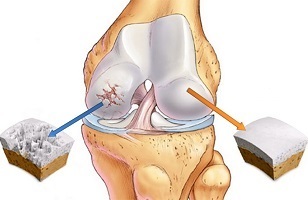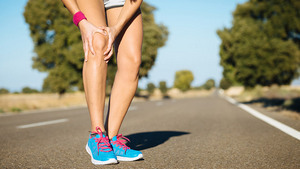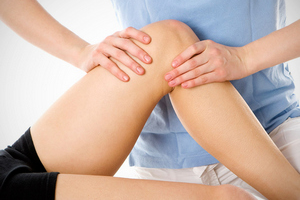
Osteoarthritis of the knee joint is one of the most common diseases of the joints, and according to the severity of the disease it is in second place after coxarthrosis.
According to the latest research, this disease occurs in every fifth adult on earth. In the material, we will tell you what are the symptoms of this disease and how to treat it properly so that complications do not occur.
Reasons for occurrence
Every day, a person's knee joints are exposed to stress, because during a walk, they can bear the entire body weight by doing sports. Over time, the cartilage tissue wears out, leading to changes in the joints. For this reason, older people can experience osteoarthritis of the knee joints.
In addition, there is a risk group, which includes people:
- overweight;
- suffering from osteoporosis;
- with hereditary disorders;
- elderly people;
- work in certain high-load specialties;
- who have metabolic disorders;
- with a lack of trace elements in the body;
- with spinal injuries;
- athletes.
It should be borne in mind that this disease develops quite slowly and it is very important to consult a doctor in time if the main symptoms are found.
This will avoid possible complications such as disability in the future.
Symptoms of knee osteoarthritis
To pinpoint the disease, just pay attention to the symptoms - they are quite common in osteoarthritis. These include:

- Pain or discomfort after sleeping (or when trying to get up after a long sitting).
- Knee pain on prolonged standing.
- When you climb the stairs - a burning sensation.
- Night pain or discomfort after exercise.
- Feeling of weakness and "twisting" in the lower limbs.
One of the most important symptoms is pain and burning in the knee area.
At the same time, the disease itself does not appear "suddenly": such feelings can grow for months or years, and at first will only bother with increased loads, and then the pain will be felt even at rest.
But it is worth remembering that the symptoms vary depending on the degree of the disease.
Let's take a closer look at each option.
I degree
Osteoarthritis of this degree is almost asymptomatic, but there are a number of factors that are characteristic of this stage of the disease:
- feeling of fatigue in the limbs;
- reduced mobility that usually occurs after sleep.
If there is pain, it is almost invisible. At this stage it is very difficult to diagnose the disease, so you can not do without an X-ray: osteoarthritis will manifest as a small bump on the surface of tissues and bones.
II degree
At this "stage" the symptoms are stronger. Pain can occur even with a small load on the legs, and over time such feelings can appear with a simple movement. The discomfort disappears only after a long rest.
In addition, symptoms such as:
- crunching when moving;
- changes in the bones in the joint;
- synovitis;
- inability to bend the leg.
III degree
A characteristic feature of this degree is severe pain, which no longer depends on the load: the joints can interfere even at night in the absence of movement.
Mobility is also impaired - a person cannot bend the leg at the knee. Sensitivity to time can also be noticed.
Diagnosis and principles of further treatment

The doctor will, after hearing the doctor, examine the appearance of the knee and assess its mobility. After that, the patient will be sent for an X-ray, and several images can be taken during the treatment period, which will enable the assessment of the dynamics of the development of arthrosis. In some cases, MRI or tomography is prescribed.
If research is needed to properly identify the underlying cause of osteoarthritis and separate it from other diseases with similar symptoms.
Treatment usually includes the following:
- Drug therapy.
- Massage and manual therapy.
- Surgical intervention.
- Exercise therapy and other methods of rehabilitation therapy.
The main goals of the treatment are the following:
- pain relief;
- restoration of ligament apparatus and destroyed cartilage;
- increased range of motion in the wrist.
Massage procedures, exercise therapy, and even proper nutrition are also important. If you visit the doctor too late or none of the above methods will help you, surgery will be prescribed: implantation of an endoprosthesis.
Treatment of arthrosis - choice of methods and means
There are currently such groups of drugs that are prescribed to treat early-stage osteoarthritis:
- NSAIL - nonsteroidal anti-inflammatory drugs;
- chondroprotectors;
- medicated ointments;
- compressor tools.
NSAIDs are aimed at eliminating pain and inflammation. And only after the pain syndrome has subsided can further treatment begin.
If the use of nonsteroidal drugs has not given any results, especially if the disease is only progressing, doctors usually prescribe hormonal drugs.
However, it is worth remembering that due to a number of side effects, such drugs are prescribed only during the period of illness - if fluid accumulates inside the joint. The solution is injected at most once every 10 days.
The only group of agents that directly affect the cause of osteoarthritis are chondroprotectors. They are especially effective in the early stages.
Hyaluronic acid injected into the joint is also very effective in the early stages. This procedure is not the cheapest, but it helps to grind the cartilage surface.
When arthrosis is detected, fats are prescribed - they also reduce the feeling of pain and eliminate inflammation.
How traditional medicine can help
It should be said right away that you should not use only the methods of traditional medicine - they should be used only as an adjunct to treatment.
Let's look at some things that can help with osteoarthritis of the knee:
Dandelion flowers
You only need to eat 5 dandelion flowers a day, be sure to rinse them with boiled water. You can also make tinctures: take 5 bottles of dark glass, fill 50% of the flowers, fill the bowl with triple cologne to the neck. Insist for a month, then wipe your knees with the infusion.
Lapping

This is a joint that must be rubbed regularly into the knee joint.
To make such a composition is very simple: take an egg yolk, mix with 1 tbsp. l. turpentine, add 1 tsp. Vinegar. All ingredients must be mixed and left overnight.
Lubricate your knees every night with a woolen scarf on top.
Moreover, it is very important to apply the applied mixture well in the morning. To alleviate the symptoms, you need to use this method for 2-3 weeks.
Velcro
According to folk effects, you need to attach 3-4 large burdock leaves to a sore knee and wrap it with a bandage. Repeat this manipulation for at least a week to relieve the pain. And to enhance the effect, you need to lubricate the joints with cinquefoil oil.
Celandine juice
Soak a piece of cloth with juice and place it on the affected knee. After an hour, wash with vegetable oil. Repeat the procedure for a week.
Harpagophytum root
Take 2 tbsp. l. that is, pour into a thermos, pour 1 liter of boiling water, leave for two hours. Take warm at least 3 glasses a day.
Choosing knee pads for osteoarthritis
It is often recommended to wear special knee pads in case of osteoarthritis of the knee joint, which reduce the feeling of discomfort and have a therapeutic effect. Normally, when used for a short time, you will see improvements such as:
- the inflammatory process is reduced;
- swelling disappears;
- pain relief;
- reduces pressure on the joints;
- The work of the musculoskeletal system is stabilized.
It is very important to choose the right model that will be effective when worn. To do this, let’s first study what types of knee pads are:

- Open.Important for those who have pain after suffering any injury or minor pain.
- Elastic productswith stiffeners. This type of knee pad is more suitable for those who have pain in squatting, climbing or descending stairs.
- Openadjustable tension knee pads. Such products are ideal after surgery.
- Closed type- used if the source of pain is unclear, ie not concentrated in any particular place. It allows you to reduce stress on the joints.
- The magnetic appearanceof the knee pillow is characterized by the presence of a special magnet, thanks to which there is a warming effect, blood circulation is improved.
- Hinged.Considered a universal option. It is used to reduce pain after injury, arthrosis.
In addition to the type, you must also consider the material from which the knee pad is made. So, such items can be made from:
- Animal fur.These products warm, absorb moisture, reduce inflammation and improve blood circulation in tissues.
- Polyester.Knee pads made of this artificial fabric are very comfortable, reliable, but do not heat up and are quite expensive.
- Cotton.Nice to wear, waterproof. True, there are drawbacks: lack of elasticity and fragility of use.
- Nylon.Knee pads made of this material are considered the most durable, they fit nicely to the body. But there is also a minus - it is an artificial material.
- Neoprene.Although it is an artificial fabric, this material is elastic and has a warming effect. There is also a drawback - wearing such knee pads can cause allergies.
But it is important not only to choose the right knee pads, but also to use them. Doctors give a few important recommendations to follow:
- you must not wear them for more than three hours a day;
- duration of wearing depends on the degree of arthrosis - your doctor will inform you in more detail;
- if you have an allergy, you must urgently visit a doctor who will prescribe you a second bandage;
- it is impossible for the agent to squeeze the joints strongly;
- wash your knee pads by hand, the water temperature should not exceed +40 degrees.
In conclusion, we must say that you should not neglect a healthy lifestyle - in this case the body will function properly. If you feel joint pain, you need to see a doctor immediately to make a correct diagnosis.

























